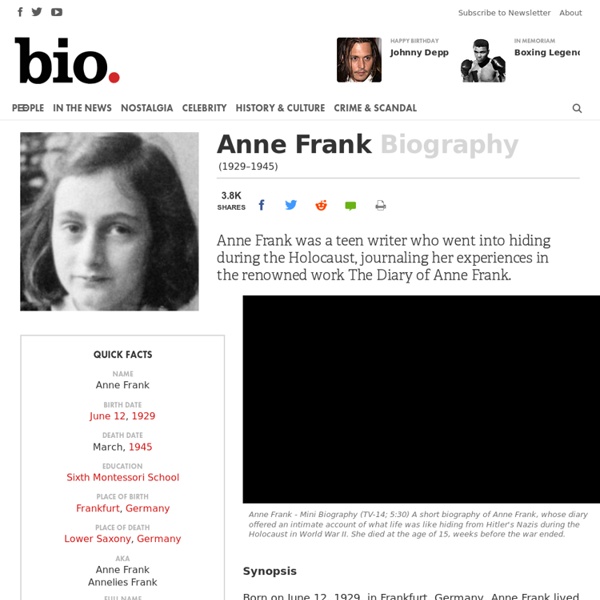Anne Frank - Biography -

Guía web Ana Frank - Banco de fuentes única en línea para alumnos europeos
Aquí imágenes e información Ana Frank Familia Casa de atrás El final Diario La Guerra La vida judía Shoá La liberación
Ana Frank
Ana Frank
Annelies Marie Frank Hollander, conocida en español como Ana Frank (Fráncfort del Meno, 12 de junio de 1929-Bergen-Belsen, marzo de 1945)[1] [nota 1] fue una niña judía alemana, mundialmente conocida gracias al Diario de Ana Frank, la edición en forma de libro de su diario íntimo, donde dejó constancia de los casi dos años y medio que pasó ocultándose, con su familia y cuatro personas más, de los nazis en Ámsterdam (Países Bajos) durante la Segunda Guerra Mundial. Su familia fue capturada y llevada a distintos campos de concentración alemanes. El único sobreviviente de los ocho escondidos fue Otto Frank, su padre. Ana fue enviada al campo de concentración nazi de Auschwitz el 2 de septiembre de 1944 y, más tarde, al campo de concentración de Bergen-Belsen, donde murió de tifus en marzo de 1945, pocos días antes de que éste fuera liberado.[3] En 1947, apenas dos años después de terminada la guerra, Otto publicó el diario bajo el título La casa de atrás (en neerlandés, Het Achterhuis).
Related:
Related:




Anne Frank and Mattie and Sarah were both young girls who went through an incredibly tough time were they suffered mental and physical abuse. They were approximately the same age and they were separated from their parents. Also, the only people affected by the residential schools were children (like Mattie and Sarah) and children were also the most affected during the holocaust (many children were immediately killed when they arrived at the camps). Even though, Mattie and Sarah are fictional characters, all three girls lived during a important historical period. Sadly, in both cases, the atrocities that they were forced to live were only revealed after they were finished. by amelie.sophie.sweg Oct 31
Anne Frank, Sarah and Mattie are alike in someway. They both had to live in pain for awhile. Mattie and Sarah lived with abuse and Anne lived with the constant fear of being killed or found everyday for a really long time. They didn't know what was waiting for them if they would step into the real world. They probably never thought that what happened to them was going to happen in their life. It is not very common. by amelie.sophie.sweg Oct 31